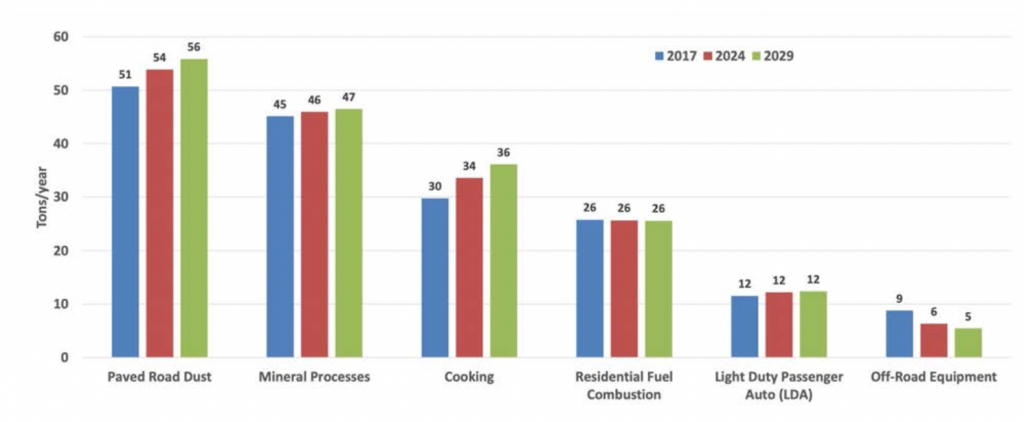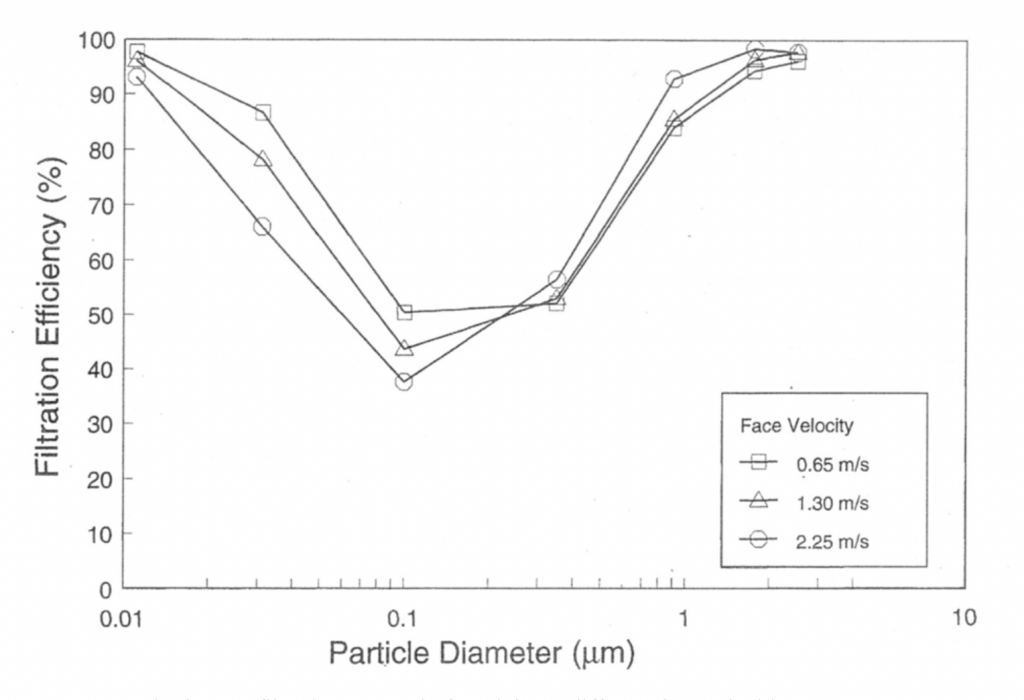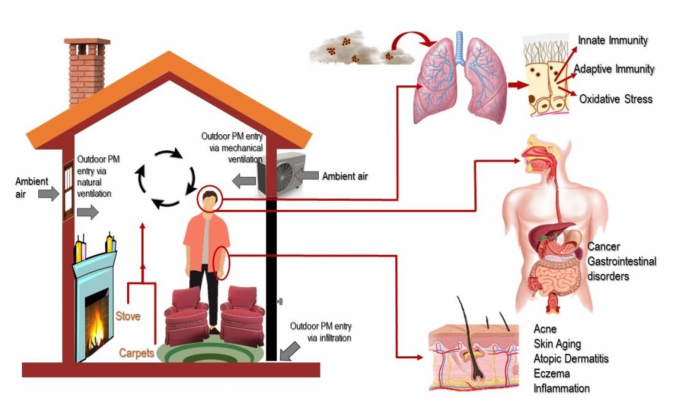We can define particulate matter (PM) as a mixture of solid particles and liquid droplets found in the air. PM can originate from two major sources, Primary, that is to say, indoor and outdoor direct sources, and secondary sources, meaning PM is formed by atmospheric reactions. The exposition to PM can have a huge impact on human health, and there is a need to monitor and control Indoor PM exposure, to protect humans.
PM2.5 (fine inhalable particles, with diameters that are generally 2.5 micrometers and smaller), PM10, and Ultra-Fine particles will not interest us here. We may ask, What are the sources and effects of Indoor fine particulate matter (FPM) and how to control and mitigate it?
Indoor sources are dependent on inhabitants’ habits, and household equipment. Because indoor sources are generally linked to cooking and heating using biofuels (coal and wood). Less well-off people, use less efficient home appliances, and people coming from poorer countries are more susceptible to being exposed to FPM from indoor sources. Especially, we consider that the biggest part of FPM [1] .Indoor emissions, comes from cooking and heating (see graph 1). On the other hand, widely used objects such as burning candles or oil lamps, are fewer known but very important sources of FPM [2]. Aerosol resuspension (process of detachment and transport of a particle, away from a surface), can be generated by all the occupant activities, such as walking and moving around. It increases the indoor supermicron particles, that is to say, some FPM. Resuspension is governed by particles properties ( size, mass, shape), but also by an environmental factor ( depending on ventilation and surfaces). And by a factor linked to human activities [3].
Tobacco smoke is also a well-known indoor source of FPM. Finally, ignored for a long time, the effects of asbestos are now known and are responsible for a lot of emissions in houses where it was used.
But PM located indoors can also originate from outdoor sources, or be particles generated due to chemical reactions between indoor precursors and outdoor sources. FPM coming from the outside usually represents a huge quantity of indoor fine FPM. FPM, infiltrates homes from both, natural and mechanical ventilation, and comes from a lot of different origins, industrial (soil dust, mineral processes, combustion ), natural (sea salt, forest fires, animal debris, bacteria), and transportation (road dust, evaporative gasoline emissions from transport). And because FPM can be transported by wind force, it can originate from very distant sources.

Figure 1 shows that outdoor emissions dominate emissions, those numbers can be relativized because those data come from an urban industrial area.
When we talk about exposure, we very often think about absorption, by nose or mouth, creating big concerns, because human neither the nose nor mouth can’t filtrate FPM. Health consequences can be dramatic and were even considered to appear in the Top 10 of 2016 Leading global health risk factors [4]. PM2.5, due to its small size penetrates deep into the lungs, and can even infiltrate the bloodstream, thus can create heart and lung diseases, which can be incapacitating, and even fatal. But we shall not forget cutaneous absorption, The four different ways that PM penetrates the skin are by mechanical delivery, intracellular, transcellular, and trans-follicular route. All those exposures combined can create, incapacitating issues such as eczema and inflammation, but also issues that we would not suspect, such as acne and gastrointestinal disorder [5][6].
We will now explore the possibilities to mitigate indoor exposure to FPM. A first strategy is to limit as much as possible behavior that creates indoor emissions ( more efficient cooker, heater, stopping smoking inside, dust-creating activities), or at least to ventilate during those activities. Finally, concerning aerosol resuspension, to address the environmental factor of emission, wisely chosen surfaces, with a low resuspension rate will permit limited resuspension, but cleaning more often and right after deposition will have similar results. Changing habits leading to resuspension when it is possible (leaving shoes outside, limiting movement on carpet) will be a way to address the human activity factor of resuspension [9].
Concerning PM that originates from the outside, it seems important to monitor outside concentration FPM and to ventilate while it will permit to reduce indoor concentration, it is nowadays easy to do so since a lot of app or website provides PM2.5 concentration outside in real-time. For new buildings, this problem can be addressed during the design stage, windows should be oriented in such a way that FPM coming from outdoor sources flow doesn’t enter. It means taking into account wind-carried FPM from the close environment that could be a source of FPM (roads, factories) and improving houses isolation to limit FMP entering. Finally, limitation of indoor fine PM coming from outside can also be achieved by the limitation of Outdoor emission, by tightening the standards for industries and transport [8][9].
Air filtration consists in placing a filter into an HVAC system for it to capture the FPM of air that is recirculated.

In lab measurement of filtration removal for different air velocities [9]
This graph shows that PM2.5 can be very efficiently removed by an HVAC filtration system. It is important to note that in-situ results would show less good, because of the bypass phenomenon. Important parameters to take into account are the recirculation rate [h^-1] that governs the quantity of air filtrated, and the run time of the systems. Because the filtration system is active only when HVAC is running, it is necessary to have it running as long as possible, and at a specific moment ( after an indoor emission). Filters need to be changed when less effective. Then for HVAC-equipped homes, a well-installed and monitored filter permits to mitigate indoor FPM exposure.
To conclude, the effects of FPM on human health are very important and have to be addressed. It is necessary to identify the sources, to mitigate FPM indoor exposure coming from different sources, which will consist of better isolation, the banning of some activities, and better ventilation strategies.
References :
- Wu,C.C.;Bao,L.J.;Tao,S.;Zeng,E.Y. Dermal Uptake from Airborne Organics as an Important Route of Human Exposure to E-Waste Combustion Fumes. Environ. Sci. Technol. 2016, 50, 6599–6605. [CrossRef]
- https://www.health.ny.gov/environmental/indoors/air/pmq_a.htm
- Jing Qian, Jordan Peccia Andrea R. Ferro, Walking-induced particle resuspension in indoor environments : https://doi.org/10.1016/j.atmosenv.2014.02.035
- GBD 2016 Risk Factors Collaborators, Lancet 390: 1345-1422, 2017
- im,K.E.;Cho,D.;Park,H.J.Air pollution and skin diseases : Adverse effects of airborne particulate matter on various skin
diseases. Life Sci. 2016, 152, 126–134. - https://www3.epa.gov/region1/airquality/pm-human-health.html
- https://www.epa.gov/indoor-air-quality-iaq/indoor-particulate-matter
- https://www.mdpi.com/1660-4601/18/21/11055
- https://nap.nationalacademies.org/read/26331/chapter/1

